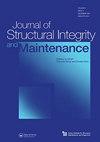Characteristics of saferoom/shelter wall structures—a state-of-the-art review
IF 3.1
Q2 ENGINEERING, CIVIL
Journal of Structural Integrity and Maintenance
Pub Date : 2022-09-30
DOI:10.1080/24705314.2022.2088330
引用次数: 0
Abstract
ABSTRACT There are several ongoing humanitarian crises all around the world that have led to many refugees, who need affordable shelters and saferooms. Additionally, these structures are widely located in the backyard of homes in case of hurricanes, tornados, and/or earthquakes. This paper presents a chronological literature review of investigations and comparisons on characteristics of different type of saferoom/shelter wall systems. The characteristics, scrutinized in this study for each type of wall, include structural strength, construction cost, time to construct, and sustainability of saferoom/shelter walls. The most significant contributions of these studies are identified and presented. The results showed that soilbag shelter walls can be constructed with relatively low cost, relatively shorter time, and being relatively more sustainable compared to other types of shelter walls considered in this study. Soil-filled earthbag specimens are stronger and stiffer than gravel-filled specimens of identical size and stack geometry. Using locally available materials minimizes the energy needed and pollution produced due to material transportations. Furthermore, recyclable waste bags can be used to produce bags in soilbags. A slanted roof can be used in any type of shelter wall to harvest rainwater for each shelter use. Moreover, the literature review indicated that the shelter walls made of CLT, and lumber panels are generally stronger against wind loads (250-mph) compared to walls made of soilbags (225-mph).安全室/遮蔽墙结构的特点——最新综述
摘要世界各地正在发生的几场人道主义危机导致许多难民需要负担得起的住所和安全室。此外,这些建筑广泛位于家庭后院,以防飓风、龙卷风和/或地震。本文对不同类型的安全室/遮蔽墙系统的特征进行了调查和比较,并按时间顺序进行了文献综述。在本研究中,对每种类型的墙进行了仔细研究,包括结构强度、施工成本、施工时间以及安全室/遮蔽墙的可持续性。确定并介绍了这些研究中最重要的贡献。结果表明,与本研究中考虑的其他类型的遮蔽墙相比,土袋遮蔽墙可以以相对较低的成本、相对较短的时间建造,并且相对更具可持续性。填土土袋试样比相同尺寸和堆叠几何形状的砾石土袋试样更坚固、更坚硬。使用当地可用的材料可以最大限度地减少材料运输所需的能源和产生的污染。此外,可回收的垃圾袋可用于制作土壤袋中的袋子。倾斜的屋顶可以用于任何类型的遮蔽墙,为每个遮蔽墙收集雨水。此外,文献综述表明,与土袋墙(225英里/小时)相比,由CLT和木板制成的遮蔽墙通常更能抵御风荷载(250英里/小时的风荷载)。
本文章由计算机程序翻译,如有差异,请以英文原文为准。
求助全文
约1分钟内获得全文
求助全文
来源期刊

Journal of Structural Integrity and Maintenance
ENGINEERING, CIVIL-
CiteScore
3.90
自引率
9.50%
发文量
24
 求助内容:
求助内容: 应助结果提醒方式:
应助结果提醒方式:


